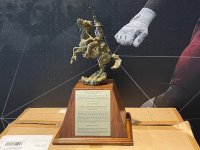Gamecock Fanatics
You are using an out of date browser. It may not display this or other websites correctly.
You should upgrade or use an alternative browser.
You should upgrade or use an alternative browser.
The trophy the Gamecocks finally got after 9 tries its here in sorts
- Thread starter FeatheredCock
- Start date
What is it? I know a guy on a horse.
But what is the significance of it in this series?
But what is the significance of it in this series?
What is it? I know a guy on a horse.
But what is the significance of it in this series?
Bonham, James
www.thealamo.org
Bonham, James
Age: 29Rank: Second Lieutenant
From: South Carolina
James Bonham, officer of the Alamo garrison, son of James and Sophia Butler (Smith) Bonham, was born at Red Banks (present-day Saluda), Edgefield County, South Carolina, on February 20, 1807. Recent evidence indicates that he was a second cousin of William B. Travis. Bonham entered South Carolina College (later the University of South Carolina) in the fall of 1823 but never graduated.
During his senior year he led a student protest against the poor food served at the college and the obligation of students to attend class in bad weather. He and a number of other students, perhaps the entire senior class, were expelled. Bonham took up the study of law and began practicing in Pendleton, South Carolina, in 1830. On one occasion he caned an opposing lawyer who insulted Bonham's female client. When ordered to apologize by the judge, Bonham threatened to tweak the judge's nose and was promptly sentenced to ninety days for contempt of court.

James Bonham - Wikipedia
He served as an aide to Governor James Hamilton Jr. during the Nullification Crisis in 1832. Bonham brandished a sword and pistol, condemning Andrew Jackson and the Washington politicians. His outspoken position brought him the rank of lieutenant colonel. At the same time he served as captain of a Charleston artillery company.
In October 1834, Bonham moved to Montgomery, Alabama, where relatives lived. The following year he went to Mobile, where he helped organize a company of militia cavalry called the Mobile Greys to serve in Texas. The company reached San Felipe, Texas in November 1835, and Bonham was commissioned a lieutenant in the Texian Cavalry on December 3.
Texas and the Alamo
On December 1, 1835, he wrote to Sam Houston from San Felipe volunteering his services for Texas and declining all pay, lands, or rations in return. In December 1835, he was commissioned a second lieutenant in the Texas cavalry, but apparently was not assigned to any specific unit. He had time to set up a law practice in Brazoria and was advertising the fact in the Telegraph and Texas Register by January 2, 1836.
Bonham and Houston quickly developed a mutual admiration. After being in Texas for only one month Bonham recommended to Houston that William S. Blount of North Carolina be granted a commission as a captain in the Texas cavalry. On January 11, 1836, Houston recommended to James W. Robinson that Bonham be promoted to major, for "His influence in the army is great, more so than some who `would be generals'." Bonham probably traveled to San Antonio de Béxar and the Alamo with James Bowie and arrived on January 19, 1836. On January 26 he was appointed one of a committee of seven to draft a preamble and resolutions on behalf of the garrison in support of Governor Henry Smith. On February 1 he was an unsuccessful candidate in the election of delegates to represent the Bexar garrison at the Texas constitutional convention.
He was sent by Travis to obtain aid for the garrison at Bexar on about February 16, 1836. He visited Goliad, but the commander of the forces there, James Fannin, was unable to provide assistance. Bonham's inimitable spirit is best described by T.R. Fehrenbach in his Texas opus, Lone Star: A History of Texas and the Texans:
"At the end, the weary Bonham, a lawyer, a Carolinian of exulted family and a friend of Travis, turned his mount around and rode back toward San Antonio. He was told it was useless to throw away his life. He answered back that Buck Travis deserved to know the answer to his appeals, spat upon the ground, and galloped west into his own immortality."
Thus, Bonham returned to the Alamo on March 3, bearing through the Mexican lines a letter from Robert McAlpin Williamson assuring Travis that help was on its way and urging him to hold out. Bonham died in the battle of the Alamo on March 6, 1836, aged 29. He is believed to have died manning one of the cannons in the interior of the Alamo chapel.
I heard the TV guys mention Bonham's role at the Alamo, but in all honesty, I was ignorant of his role in this important part of American history until now.
Great question!
Last edited:
Known as the Bonham Trophy.

Sa-lute!!

Sa-lute!!
Last edited:
Cool thanks for the info.
Let's make sure we keep it for a while.

Last edited:
FurmanCock
Grand Poohbah
Let's make sure we keep it for a while.

I love this painting...Elvis at the Alamo, affectionately known as TCBY Texas style.



